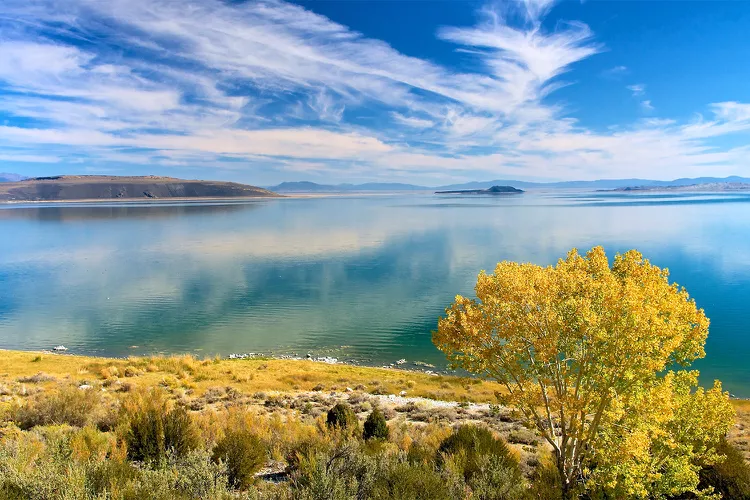Summary of Mono Lake
Discovering Mono Lake
Mono Lake (rhymes with “OH no”) stands as the largest natural lake entirely within California. Originally endangered when water sources were redirected to Los Angeles, the lake lost a dramatic volume over four decades before conservation efforts began.
As it stands today, Mono Lake is beneath the desired elevation of 6,392 feet. Continuous drought has hindered recovery, with expectations that it may not reach this level until well into the 2020s.
Renowned for its stunning tufa (TOO-fuh) towers, Mono Lake’s historical water levels have led to remarkable geological formations. The current salinity level is 2.5 times higher and 80 times more alkaline than the ocean, a reflection of the lake’s unique ecosystem.
Previously, higher lake levels saw the infusion of freshwater springs that reacted with the lake’s minerals, creating the striking, city-like formations that dot Mono Lake’s shores.
Reasons to Go Now
As the lake slowly fills, noteworthy tufa towers gradually become less visible. While this reflects positive ecological change, those wishing to witness these majestic formations should visit soon to capture their magnificence before they diminish.
Things to Do at Mono Lake
Mono Lake captivates visitors from any angle, with a variety of activities to enhance your experience:
- Mono Lake Visitor Center: Located off US Hwy 395, the visitor center offers exhibits detailing the area’s captivating history and current conditions.
- South Tufa Reserve: This area features the most impressive tufa towers, with opportunities to walk among them—at least for now.
- Naturalist Tours: Summer provides chances to join a boat or walking tour exploring the tufa towers.
- Photography: Capture stunning photographs of the tufa formations against breathtaking sunsets. Arrive early for the best light, especially during sunset, as the sun dips below the mountains faster than expected.
- Lake Tours: Experience Mono Lake up close by canoeing with Caldera Kayaks or through a tour by the Mono Lake Committee.
- Bird Watching: In the fall, the lake becomes a temporary home for migratory birds along the Pacific Flyway.
Exploring South Tufa

With no natural outlet, Mono Lake has accumulated minerals over time, rendering it saltier than ocean water. The unique interaction between freshwater springs and this alkaline lake leads to the formation of the remarkable tufa towers, once submerged, now visible as they rise from the water.
Visitors frequently stop at the South Tufa Reserve, which showcases tufa towers often worn by climbers, contrasting with those protected from human activity and capable of showcasing their delicate textures.
Birdwatching Opportunities

Mono Lake serves as a critical waypoint for migratory birds, endorsing a sanctuary for nearly 100 species. Among them is the small yet formidable Red-Necked Phalarope, which builds its strength before embarking on a 3,000-mile journey to the Andes.
In fall, approximately 2 million Eared Grebes congregate, seizing the opportunity to feast on the abundant resources the lake offers.
During June, avid birders flock to Mono Lake for the annual Bird Chautauqua event, featuring field trips and lectures centered around avian activities. Spaces fill quickly due to high demand, signifying the event’s popularity.
Tips for Visiting Mono Lake

When planning your visit to Mono Lake, consider these insightful tips:
- Timing is crucial for photography – arrive well in advance of sunset to enjoy optimal lighting conditions.
- The lake’s water has a slippery feel; avoid contact with shoes and clothing as it may degrade the materials.
- Be prepared for muddy terrain; many visitors lose footwear in the mud, leading to the nickname “Sneaker Flat.”
- Swimming is a unique experience here, akin to floating in the Great Salt Lake due to the high salinity levels.
What You Need to Know
Visitor access to the South Tufa Reserve is subject to a day-use fee.
Location: Mono Lake, Lee Vining, CA. The visitor center can be found just off US 395 north of Lee Vining, with the South Tufa Reserve located east on CA 120.





